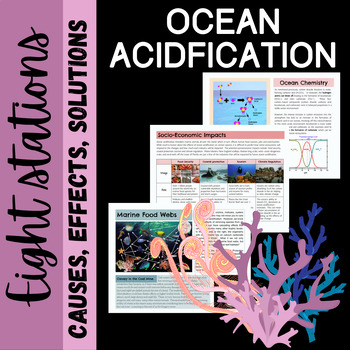Ocean Acidification Causes and Effects: Stations
Biology with Brynn and Jack
962 Followers
Grade Levels
9th - 12th
Subjects
Resource Type
Standards
NGSSHS-LS2-7
NGSSHS-ESS3-1
NGSSHS-ESS3-5
Formats Included
- Zip
Pages
12 pages
Biology with Brynn and Jack
962 Followers
What educators are saying
One of my favorite stations to use in my marine science class. The stations are very thorough and informative
My students loved this activity. It was a perfect way for the students to interact with the material. We had some great discussions about carbon sequestration.
Description
This product is a great way to introduce your students to the causes and effects of ocean acidification. Students travel from station to station analyzing information, data and graphs relating to climate change and recording their ideas on the answer sheet provided (SEE PREVIEW). Print, laminate, and have students walk from station to station with their student answer sheet.
The topics covered at each station include:
- Carbon Dioxide in the water
- Ocean Chemistry
- Ocean pH
- Calcium Carbonate
- Marine Food Webs
- Acidification is Uneven, worldwide
- Socioeconomic Effects
- Possible Solutions
I have uploaded this in both a PDF and .pptx format, so you can modify and differentiate for your classroom and students' needs. Enjoy!
Total Pages
12 pages
Answer Key
Included
Teaching Duration
N/A
Last updated Mar 26th, 2021
Report this resource to TPT
Reported resources will be reviewed by our team. Report this resource to let us know if this resource violates TPT’s content guidelines.
Standards
to see state-specific standards (only available in the US).
NGSSHS-LS2-7
Design, evaluate, and refine a solution for reducing the impacts of human activities on the environment and biodiversity. Examples of human activities can include urbanization, building dams, and dissemination of invasive species.
NGSSHS-ESS3-1
Construct an explanation based on evidence for how the availability of natural resources, occurrence of natural hazards, and changes in climate have influenced human activity. Examples of key natural resources include access to fresh water (such as rivers, lakes, and groundwater), regions of fertile soils such as river deltas, and high concentrations of minerals and fossil fuels. Examples of natural hazards can be from interior processes (such as volcanic eruptions and earthquakes), surface processes (such as tsunamis, mass wasting and soil erosion), and severe weather (such as hurricanes, floods, and droughts). Examples of the results of changes in climate that can affect populations or drive mass migrations include changes to sea level, regional patterns of temperature and precipitation, and the types of crops and livestock that can be raised.
NGSSHS-ESS3-5
Analyze geoscience data and the results from global climate models to make an evidence-based forecast of the current rate of global or regional climate change and associated future impacts to Earth's systems. Examples of evidence, for both data and climate model outputs, are for climate changes (such as precipitation and temperature) and their associated impacts (such as on sea level, glacial ice volumes, or atmosphere and ocean composition). Assessment is limited to one example of a climate change and its associated impacts.





